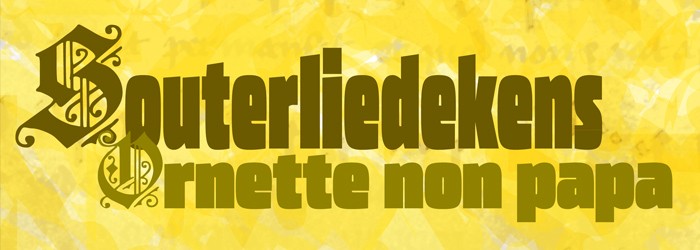
Souterliedekens – Ornette non Papa 2009
Autumn 2009 will bring us a production with two of Holland’s top improvisers.
Dutch music was thriving in the Renaissance. The development of counterpoint, culminating 200 years later in Bach’s music, found highly creative fertile ground in the Netherlands ruled at the time by the count of Burgundy.
How can Renaissance music be of interest to jazz musicians? In jazz’ history there are two distinct periods where the music is clearly polyphonic and counterpointilistic. The sound of the ‘classic’ bands of New Orleans at the beginning of the nineteen hundreds is so distinct becaus e of the improvisations of cornet, clarinet and trombone in counterpoint. At the beginning of his carreer Louis Armstrong played polyphone music all the way before he developed singlehandely ‘solo playing’ as an art form! In the nineteen fifties Ornette Coleman reintroducd this polyphone playing in jazz. Unfortunately it got missnamed as ‘Free Jazz’. Ornette’s own term ‘Harmolodics’ (harmony, melody and rythm are of equal influence on one another) and more recently ‘Sound Grammar’ (speach/talking is the creator of thoughts and ideas) are more adequate.
“If we can determine the paralels between the Dutch school of the sixteen hundreds and the polyphone structures used in jazz in the ninteen hundreds, why not make a programm consisting of compositionsby masters of both eras?” so Wolfgang Schmidtke.
The concerts presented in this series will consist of two suites. One suite will feature contemporary improvisation techniques interwoven in compositions from Dutch Renaissance composers. The second suite will feature compositions by Ornette Coleman, the ‘reinventer’ of polyphone playing in the jazz of the late fifties/early sixties. One can easily jump to the conclusion that, just over 50 years ago, Ornette started to incorporate the ideals of the Renaissance composers in jazz. With his polyphone playing band he had to make this drastic turn away from mainstream jazz to get closer to his own roots (his family moved from New Orleans to Texas in the late twenties).
The democratic way of playing, interweaving voices rather then putting them on top of each other relegating some as ‘background’ or accompaniment, is also the basis on which Dutch Renaissance music was built. One of the first examples of polyphony we find in the Souterliedekens (Sweet Songs) by a Jakobus Clemens. Of immens popularity and contemporary of the Pope Clemens VII. In order to not get mixed up with the church leader he signed his name as Clemens Non Papa.
We proudly present this programm with compositions by Dutch Renaissance composers and Ornette Coleman. However it must be clear that improvised music and its players find inspiration in almost anything!
This programm is supported by the Dutch Consulate General in Düsseldorf.
